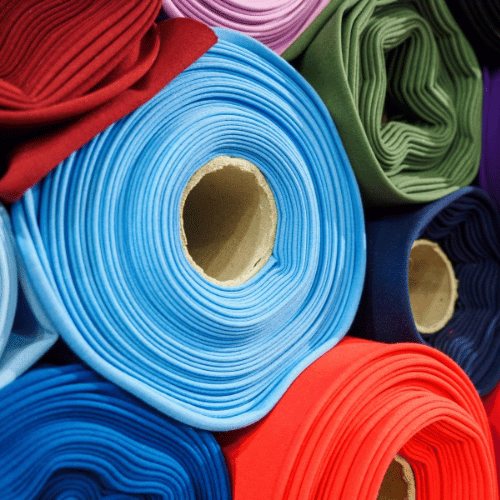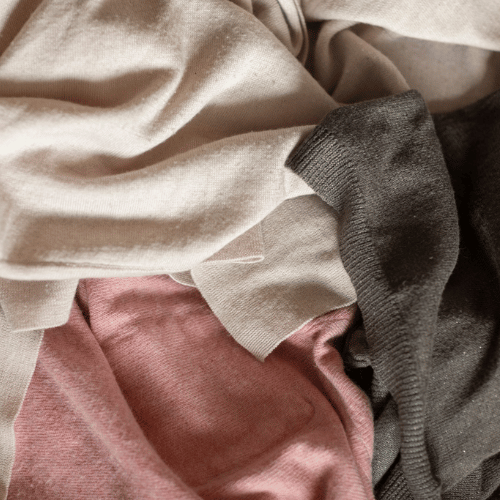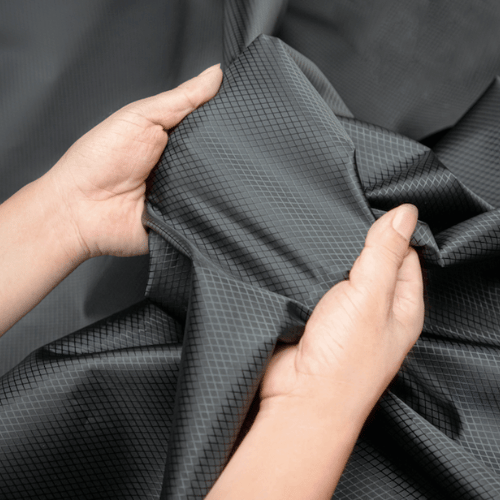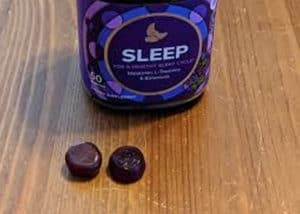The debate between lyocell and polyester has been ongoing for a long time. But which material should you choose for your clothing?
Lyocell is a type of rayon fabric made from wood pulp cellulose. It’s often referred to as Tencel, which is a brand name owned by Lenzing AG.
Polyester, on the other hand, is made from synthetic fibers derived from petroleum products. It’s one of the most popular fabrics in today’s fashion industry.
So how do these two fabrics compare? We’ll look at their sustainability, breathability, comfort and cost to determine which one is better suited for everyday wear.
Read on to find out more about lyocell vs polyester.
Definition Of Fabrics

Lyocell and polyester are two fabrics commonly used in clothing.
Lyocell is a type of rayon, which is a semi-synthetic fabric made from cellulose.
Polyester is a synthetic fabric made from petroleum-based products.
Both fabrics offer durability and low cost, but have distinct characteristics that make them suitable for different clothing needs.
Lyocell is lightweight, soft to the touch, and has excellent breathability and moisture-wicking properties. It’s often blended with other fabrics like cotton or wool to add strength and wrinkle resistance.
Polyester is durable and resilient, making it great for activewear that needs to withstand repeated wear and tear. It also resists wrinkling, fading, shrinking, and stretching better than other fabrics.
These two fabrics have different advantages that make them useful for different applications.
Next we’ll look at the characteristics of lyocell specifically, so you can decide if it’s right for you.
Characteristics Of Lyocell
Lyocell possesses several traits that make it a desirable fabric for clothing. It is highly absorbent, able to take up large amounts of moisture quickly before releasing it back into the air. This makes lyocell perfect for hot weather wear, as it can keep the wearer cool and dry. It is also wrinkle-resistant and has a silky texture that is soft against the skin, making it comfortable to wear.
The manufacturing process of lyocell causes it to be strong yet lightweight, making garments made from this fabric easy to move in while also being durable enough to withstand regular wear and tear. Lyocell also boasts an eco-friendly production process, showcasing its commitment to sustainability.
Finally, lyocell holds dye well and maintains its color over time with minimal fading or discoloration. This allows clothing made from lyocell to retain its vibrancy even after multiple washes. With these characteristics in mind, we can now examine the performance benefits of lyocell in more detail.
Performance Benefits Of Lyocell

It’s no coincidence that lyocell is such a popular fabric for clothing: it offers a number of performance benefits.
For starters, it has excellent breathability and can wick away moisture quickly, making it ideal for those hot summer days. It’s also lightweight and comfortable to wear, so you won’t feel weighed down by your clothes.
Plus, its wrinkle-resistant nature makes it great for traveling or going on long trips.
What’s more, lyocell is strong and durable enough to withstand regular use without showing signs of wear and tear.
Its eco-friendly production process also makes it an attractive choice for those looking to reduce their environmental impact. And because lyocell holds dye well and maintains its color over time, you can always be sure that your clothes will look just as vibrant after multiple washes.
In comparison to polyester, lyocell stands out as the superior fabric in terms of performance and sustainability.
It’s clear why this fabric is gaining popularity – not only does it offer comfort, breathability and durability, but its environmental credentials make it an ethical choice too.
Characteristics Of Polyester
By comparison, polyester is a synthetic fabric that offers its own set of characteristics.
It’s lightweight and resistant to wrinkles, making it great for those who have to travel often. Polyester is also highly durable and won’t show signs of wear after regular use.
Additionally, it has a low absorbency rate, so liquids and other substances won’t easily penetrate the fabric.
However, when it comes to sustainability and environmental impact, polyester can’t compete with lyocell. Its production process relies on petroleum-based products and generates more pollution than lyocell does.
Plus, polyester isn’t biodegradable and will take hundreds of years to break down in landfills.
Overall, there are pros and cons to both fabrics – while lyocell is more sustainable than polyester, the latter still provides many performance benefits that make it an attractive choice for clothing.
Performance Benefits Of Polyester

Polyester is a popular fabric choice in many clothing and textile products. It is lightweight and resistant to wrinkles, making it ideal for those who travel often.
In addition, polyester is highly durable and can withstand regular use without showing signs of wear.
The fabric also has a low absorbency rate, meaning liquids and other substances won’t easily penetrate it.
The performance benefits of polyester are numerous, but there are some drawbacks as well.
Polyester relies on petroleum-based raw materials for production, leading to more pollution than lyocell production. Plus, polyester isn’t biodegradable and will take centuries to break down in landfills.
Overall, while lyocell is the more sustainable option between the two fabrics, polyester still provides a range of performance benefits that make it an attractive choice for clothing.
From its low absorbency rate to its durability, polyester can be a great choice for those looking for long-lasting apparel items.
As such, it’s important to consider both fabrics when deciding which one best suits your needs before making a purchase decision. Moving forward, let’s compare their durability levels in more detail.
Comparison In Durability
Comparing the two fabrics’ durability levels requires looking at several factors.
First, polyester is more resistant to abrasion and can withstand regular use without wearing down.
On the other hand, lyocell is more prone to ripping and tearing. Additionally, polyester has a higher melting point than lyocell, meaning it won’t be damaged by hot water or steam as easily.
When it comes to UV resistance, polyester offers better protection against sun damage than lyocell does.
However, lyocell is much better when it comes to colorfastness; its colors will stay vibrant for longer than those of polyester fabrics.
Finally, both fabrics are able to resist mildew growth and shrinkage well.
Comparison In Breathability
When it comes to breathability, lyocell and polyester offer different levels of comfort. Lyocell is softer and provides a more luxurious feel against the skin.
Additionally, it absorbs moisture better than polyester and can help keep you cool and dry in warm weather. On the other hand, polyester is not as soft as lyocell, and tends to trap heat more easily.
The differences in breathability between lyocell and polyester can be distilled into three key points:
- Lyocell is softer on the skin.
- Polyester traps heat more easily than lyocell does.
- Lyocell has superior moisture absorption capabilities compared to polyester.
These key points should be kept in mind when choosing between these two fabrics for comfort purposes.
With that said, let’s move on to how the two fabrics compare in terms of cost-effectiveness.
Impact On The Environment
The environmental impact of lyocell and polyester fabrics is an important consideration. Lyocell fibers are derived from wood pulp, making them a more sustainable choice than polyester which is typically made from petroleum-based materials. Lyocell production also uses fewer chemicals and produces less waste than traditional cotton processing.
Polyester has become increasingly popular due to its low cost and versatility, but it’s not as environmentally friendly as lyocell. Polyester takes longer to break down than other fabric fibers and may release microplastics into the environment when washed or worn. However, there are some recycled polyester fabrics available that can help reduce the overall environmental impact.
When looking at the effect on the environment, lyocell is generally considered a better option than polyester. It’s more sustainable and requires fewer resources to produce, making this fabric an excellent choice for those who want to minimize their environmental footprint.
Looking ahead to care and maintenance will further inform your decision-making process.
Care And Maintenance
Caring for lyocell and polyester fabrics is relatively easy. Both fabrics are machine-washable, but lyocell should be washed in cold water to preserve its softness and color.
Polyester can usually handle warm or hot water, but it’s best to check the care label before washing to ensure the fabric won’t shrink or become discolored. When it comes to drying, both fabrics should be air-dried on a flat surface to reduce wrinkles.
When ironing either fabric, use a low setting and avoid direct steam.
Lyocell should also be protected from direct sunlight as it may fade over time. Additionally, both fabrics should be kept away from open flames or other sources of heat as they can melt or burn easily.
To keep either fabric looking new, spot clean any stains immediately and take extra care when wearing items made with these materials around rough surfaces or objects that may snag them.
With proper care and maintenance, lyocell and polyester fabrics will remain soft and durable for many years to come.
Frequently Asked Questions
How Do Lyocell And Polyester Fabrics Compare In Terms Of Softness?
Ah, softness. The elixir of life, the key to comfort, and the dream of many a fabric-lover. Who hasn’t sought out the softest material for their clothing, bedding, or upholstery? But which fabric reigns supreme in terms of softness? Does lyocell or polyester come out on top? Let’s find out!
When it comes to softness in fabrics, it’s all about the fibers. Lyocell is made from cellulose fibers that are soft and strong; polyester is made from man-made plastic fibers that can also be soft and strong.
Both fabrics can provide an incredibly comfortable feel against the skin, but there’s one key difference between them: lyocell has a higher moisture absorbency than polyester. This makes lyocell feel softer and cooler against your skin than polyester fabrics do.
So which fabric should you choose if you’re looking for something super-soft? It depends on your preferences; both lyocell and polyester offer great benefits when it comes to feeling good against your skin.
If you want something lightweight and breathable, go with lyocell; if you want something that’s more durable and resistant to wrinkles, then opt for polyester.
No matter what you choose, you’ll end up with a fabric that feels great!
What Is The Best Way To Clean And Maintain Lyocell And Polyester Fabrics?
Cleaning and maintaining fabrics can be a tricky business, like trying to navigate a minefield. The challenge of knowing which method works best for each fabric is like solving a Rubik’s cube – it requires patience, knowledge, and attention to detail.
As such, it is important to understand the best way to clean and maintain lyocell and polyester fabrics.
To start with, lyocell should be washed in cold water on a delicate cycle with mild detergent.
To dry it, lay flat or hang on a line; avoid using the dryer as heat may damage the fabric. For ironing, use low heat setting and do not apply steam.
When storing lyocell fabrics, ensure they are kept away from direct sunlight and moisture as prolonged exposure can cause yellowing or discoloration of the material.
Polyester is more tolerant than lyocell when it comes to cleaning and maintenance. It can be machine-washed on warm or cold settings with mild detergent; however, do not put it in the dryer as high temperatures may shrink the fabric.
Iron at medium-high heat setting if needed; never use steam when ironing polyester as this will cause wrinkling.
To store polyester fabrics properly, keep them away from direct sunlight or any source of extreme heat as this could cause fading over time.
Caring for lyocell and polyester fabrics requires some effort but following these steps will help keep them looking great for longer periods of time.
With proper maintenance techniques in place, these two materials can offer long-term wearability without compromising their softness or quality.
Is It Possible To Dye Lyocell Or Polyester Fabrics?
Dyeing fabrics has become a popular activity for crafting enthusiasts. It’s an enjoyable way to create unique clothing, accessories and home decor. But is it possible to dye lyocell or polyester fabrics?
The answer is yes. Both materials have the ability to absorb dye with some exceptions. They can be dyed with natural or synthetic dyes, depending on the desired color and effect.
There are a few things to keep in mind when dyeing these fabrics:
Natural Dyes:
a. Lyocell may not take up the color of natural dyes as well as polyester, so it’s best to do a test patch first.
b. Use tannins and mordants – chemical compounds used to help bind the dye molecules to the fabric fibers – when working with natural dyes on both lyocell and polyester fabrics.
Synthetic Dyes:
a. Though synthetic dyes work better on lyocell than natural dyes, it’s important to pre-wash both lyocell and polyester fabrics before dyeing them in order to remove any excess finishes that may prevent the color from taking fully.
b. Be sure not to use too much dye; if too much is applied, it could cause discoloration or fading of the fabric over time.
When done properly, you’ll be able to achieve beautiful colors on both lyocell and polyester fabrics!
With a little patience and some practice, you’ll be able to create your own one-of-a-kind pieces for any project you choose.
Are Lyocell And Polyester Fabrics Suitable For Outdoor Use?
Outdoor use is an important factor when selecting the right fabric. Both lyocell and polyester fabrics are commonly used in apparel, but do they stand up to outdoor exposure?
To determine if either of these fabrics are suitable for outdoor use, we must consider their durability and resistance to various elements.
Lyocell is a type of rayon made from wood pulp cellulose, so it’s lightweight yet strong. It’s also highly resistant to shrinking and creasing.
Polyester, on the other hand, is more durable than lyocell but can be prone to wrinkling. Both fabrics have good colorfastness and UV protection, making them great choices for outdoor use.
When it comes down to deciding which fabric is better suited for outdoor wear, it really depends on what you’re looking for in terms of performance and style. Lyocell has a soft feel that makes it comfortable while polyester offers superior strength and wrinkle-resistance. Ultimately, both fabrics make excellent choices for apparel that will be exposed to the elements.



